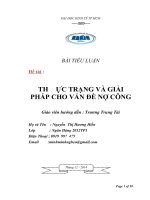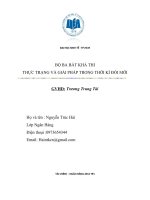Đáp Án Bài Tập Nhập Môn Tài Chính Tiền Tệ 6 Diệp Gia Luật
Bạn đang xem bản rút gọn của tài liệu. Xem và tải ngay bản đầy đủ của tài liệu tại đây (44.95 KB, 6 trang )
ĐÁP ÁN BÀI TẬP NHẬP MÔN TÀI CHÍNH
TIỀN TỆ - BUỔI 6
Giảng viên: Diệp Gia Luật
Câu 1) The interest rate charged on overnight loans of reserves between banks is the
A) prime rate.
B) discount rate.
C) federal funds rate.
D) Treasury bill rate.
Answer: C
Câu 2) The primary indicator of the Fed's stance on monetary policy is
A) the discount rate.
B) the federal funds rate.
C) the growth rate of the monetary base.
D) the growth rate of M2.
Answer: b
Câu 3) The quantity of reserves demanded equals
A) required reserves plus borrowed reserves.
B) excess reserves plus borrowed reserves.
C) required reserves plus excess reserves.
D) total reserves minus excess reserves.
Answer: C
Câu 4) Everything else held constant, when the federal funds rate is ________ the interest rate
paid on reserves, the quantity of reserves demanded rises when the federal funds rate ________.
A) above, rises
B) above, falls
C) below, rises
D) below, falls
Câu 5) In the market for reserves, when the federal funds interest rate is below the discount rate,
the supply curve of reserves is
A) vertical.
B) horizontal.
C) positively sloped.
D) negatively sloped.
Câu 6) When the federal funds rate equals the discount rate
A) the supply curve of reserves is vertical.
B) the supply curve of reserves is horizontal.
C) the demand curve for reserves is vertical.
D) the demand curve for reserves is horizontal.
Câu 7) In the market for reserves, if the federal funds rate is above the interest rate paid on
excess reserves, then an open market ________ the supply of reserves, raising the federal funds
interest rate, everything else held constant.
A) sale decreases
B) sale increases
C) purchase increases
D) purchase decreases
Câu 8) In the market for reserves, if the federal funds rate is above the interest rate paid on
excess reserves, an open market purchase ________ the supply of reserves and causes the federal
funds interest rate to ________, everything else held constant.
A) decreases; fall
B) increases; fall
C) increases; rise
D) decreases; rise
Câu 9) In the market for reserves, if the federal funds rate is above the interest rate paid on
excess reserves, an open market sale ________ the supply of reserves causing the federal funds
rate to ________, everything else held constant.
A) decreases; decrease
B) increases; decrease
C) increases; increase
D) decreases; increase
Câu 10) In the market for reserves, if the federal funds rate is above the interest rate paid on
excess reserves, an open market sale ________ the ________ of reserves, causing the federal
funds rate to increase, everything else held constant.
A) increases; supply
B) increases; demand
C) decreases; supply
D) decreases; demand
Câu 11) Everything else held constant, in the market for reserves, when the federal funds rate is
3%, raising the discount rate from 5% to 6%
A) lowers the federal funds rate.
B) raises the federal funds rate.
C) has no effect on the federal funds rate.
D) has an indeterminate effect on the federal funds rate.
Câu 12) Everything else held constant, in the market for reserves, when the demand for federal
funds intersects the reserve supply curve on the vertical section, increasing the discount rate
A) increases the federal funds rate.
B) lowers the federal funds rate.
C) has no effect on the federal funds rate.
D) has an indeterminate effect on the federal funds rate.
Câu 13) Everything else held constant, in the market for reserves, increases in the discount rate
affect the federal funds rate
A) when the funds rate is below the discount rate.
B) when the funds rate equals the discount rate.
C) when the demand for federal funds intersects the vertical section of the reserve supply curve.
D) when the demand for federal funds equals zero.
Câu 14) After 2003, The Federal Reserve usually keeps the discount rate
A) above the target federal funds rate.
B) equal to the target federal funds rate.
C) below the target federal funds rate.
D) equal to zero.
Câu 15) In the market for reserves, if the federal funds rate is between the discount rate and the
interest rate paid on excess reserves, an increase in the reserve requirement ________ the
demand for reserves, ________ the federal funds rate, everything else held constant.
A) decreases; lowering
B) increases; lowering
C) increases; raising
D) decreases; raising
Câu 16) In the market for reserves, if the federal funds rate is between the discount rate and the
interest rate paid on excess reserves, a ________ in the reserve requirement ________ the
demand for reserves, raising the federal funds interest rate, everything else held constant.
A) rise; decreases
B) rise; increases
C) decline; increases
D) decline; decreases
Câu 17) In the market for reserves, if the federal funds rate is between the discount rate and the
interest rate paid on excess reserves, an increase in the reserve requirement ________ the
demand of reserves and causes the federal funds interest rate to ________, everything else held
constant.
A) decreases; fall
B) increases; fall
C) increases; rise
D) decreases; rise
Câu 18) In the market for reserves, if the federal funds rate is between the discount rate and the
interest rate paid on excess reserves, an increase in the reserve requirement ________ the
________ for reserves and causes the federal funds interest rate to rise, everything else held
constant.
A) decreases; demand
B) increases; demand
C) increases; supply
D) decreases; supply
Câu 19) Suppose, at a given federal funds rate, there is an excess demand for reserves in the
federal funds market. If the Fed wants the federal funds rate to stay at that level, then it should
undertake an open market ________ of bonds, everything else held constant. If the Fed does
nothing, however, the federal funds rate will ________.
A) sale; increase
B) purchase; increase
C) sale; decrease
D) purchase; decrease
Câu 20) ________ are the most important monetary policy tool because they are the primary
determinant of changes in the ________, the main source of fluctuations in the money supply.
A) Open market operations; monetary base
B) Open market operations; money multiplier
C) Changes in reserve requirements; monetary base
D) Changes in reserve requirements; money multiplier
Câu 21) Open market purchases raise the ________ thereby raising the ________.
A) money multiplier; money supply
B) money multiplier; monetary base
C) monetary base; money supply
D) monetary base; money multiplier
Câu 22) Open market sales shrink ________ thereby lowering ________.
A) the money multiplier; the money supply
B) the money multiplier; reserves and the monetary base
C) reserves and the monetary base; the money supply
D) the money base; the money multiplier
Câu 23) Discount policy affects the money supply by affecting the volume of ________ and the
________.
A) excess reserves; monetary base
B) borrowed reserves; monetary base
C) excess reserves; money multiplier
D) borrowed reserves; money multiplier
Câu 24) The discount rate is kept ________ the federal funds rate because the Fed prefers that
A) below ; banks borrow reserves from each other.
B) below; banks borrow reserves from the Fed.
C) above; banks borrow reserves from each other.
D) above; banks borrow reserves from the Fed.
Câu 25) The interest rate for primary credit is usually set ________ basis points ________ the
federal funds rate. In March 2008, this gap was changed to ________ basis points.
A) 50; below; 100
B) 100; above; 25
C) 100; below; 50
D) 50; above; 25
Câu 26) An increase in ________ reduces the money supply since it causes the ________ to fall.
A) reserve requirements; monetary base
B) reserve requirements; money multiplier
C) margin requirements; monetary base
D) margin requirements; money multiplier
Câu 27) A decrease in ________ increases the money supply since it causes the ________ to rise.
A) reserve requirements; monetary base
B) reserve requirements; money multiplier
C) margin requirements; monetary base
D) margin requirements; money multiplier
5) The opportunity cost of holding excess reserves is the federal funds rate
A) minus the discount rate.
B) plus the discount rate.
C) plus the interest rate paid on excess reserves.
D) minus the interest rate paid on excess reserves.
Answer: D
Ques Status: Previous Edition
AACSB: Analytic skills
6) In the market for reserves, when the federal funds rate is above the interest rate paid on excess
reserves, the demand curve for reserves is
A) vertical.
B) horizontal.
C) positively sloped.
D) negatively sloped.
Answer: D
Ques Status: Previous Edition
AACSB: Analytic skills
7) When the federal funds rate equals the interest rate paid on excess reserves
A) the supply curve of reserves is vertical.
B) the supply curve of reserves is horizontal.
C) the demand curve for reserves is vertical.
D) the demand curve for reserves is horizontal.
Answer: D
Buổi 6
1c 2b 3c 4b 5a 6b 7a 8b 9d 10c 11c 12c 13b 14a 15c 16b 17c 18b 19b 20a 21c 22c 23b 24c 25b 26b
27b









